Papers by Seruni Freisleben
Bioenergetics, Dec 27, 2017
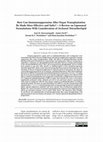
Biomedical and Pharmacology Journal, 2021
Immune-suppressive agents such as methylprednisolone and cyclosporine exert tremendous side effec... more Immune-suppressive agents such as methylprednisolone and cyclosporine exert tremendous side effects, because of high dosage and long-term application required for immune suppression after organ transplantation. Major side effects of methylprednisolone include bleeding of the gastro-intestinal tract, hypertension, and osteoporosis, whereas cyclosporine is nephrotoxic. Liposomes are phospholipid particles that allow delivery of drugs preferentially to the reticuloendothelial system. They can be prepared from phospholipids, such as lecithin from soybean or egg yolk, other specific or modified lipids or from membrane-spanning tetraether lipid (TEL), which can be extracted and purified from archaeal cell membranes. One advantage in the use of liposomal application is reduced toxicity of many drugs. We report on various liposomal preparations of cyclosporine, methylprednisolone (L-MPL) and its palmitate derivative (L-MPLP). It has been documented that liposomal cyclosporine A (L-CsA), 1.7...
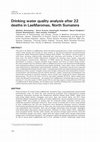
The case of 22 deaths in LaeMaromas, North Sumatera suspected due to water contamination by nearb... more The case of 22 deaths in LaeMaromas, North Sumatera suspected due to water contamination by nearby metal mining was brought by local citizens to the Church-supported non-governmental organization (NGO) Persekutuan Diakonia Pelangi Kasih (PDPK). The patients’ clinical symptoms were fever, shivering, shaking chills, abdominal pain, diarrhoea, and vomiting. In June 2011, a team from the District Health Department analysed the drinking water quality, especially microbiological contamination. Members of PDPK asked the German-Indonesian Medical Association to conduct a second complete water analysis with focus on heavy metal content. Six water samples from four different wells in LaeMaromas and two from Sopokomil and Bongkaras were analysed according to international water quality standards. Taste, odour, colour, and turbidity were determined by organoleptic and photometric methods. Temperature and pH were measured with a calibrated thermometer and pH-meter. Total dissolved solids were de...

Biomedical and Pharmacology Journal, 2018
Treatment of iron overload in thalassaemia is still a great burden for patients, their families a... more Treatment of iron overload in thalassaemia is still a great burden for patients, their families and the health care system in developing countries like Indonesia, because of expensiveness and unwanted side effects of chemical iron-chelating therapeutics. This animal study investigates an extract from the leaves of Mangifera foedica L (EMF) and its major active compound, mangiferin, for chelating and antioxidant treatment of iron overload. Sixty rats were randomly divided into 10 groups: control, iron overload (IO), and IO with mangiferin doses between 50 and 200 mg/g BW or 2390 mg of EMF, applied via gastric tubes. For comparison, deferiprone (DFP) was used. Iron overload was induced by intraperitoneal iron dextran resembling two models, transfusion-dependent (TDT) or nontransfusion-dependent thalassaemia (NTDT). Increasing oral doses of mangiferin and EMF did not result in higher mangiferin plasma levels; however, mangiferin administered for four weeks roughly doubled blood levels ...
The Southeast Asian journal of tropical medicine and public health, 2014
We investigated whether in addition to the well known genetic alteration in red blood cell membra... more We investigated whether in addition to the well known genetic alteration in red blood cell membrane band 3 protein, a deletion of 9 amino acids leading to ovalocytosis, other mutations to band 3 also exist. In 12% of our thalassemia major patients investigated, we found two bands in the agarose gel-electrophoresis of PCR products from band 3 gene with a difference of 65 +/- 10 bp, equivalent to a deletion of 20 to 25 amino acids in band 3 protein. Thus, a co-existing band 3-mutant allele in addition to the thalassemic globin gene defects, could also contribute to erythrocyte membrane defects and to the spectrum of clinical symptoms of these thalassemia major patients.
The Southeast Asian journal of tropical medicine and public health
We investigated whether in addition to the well known genetic alteration in red blood cell membra... more We investigated whether in addition to the well known genetic alteration in red blood cell membrane band 3 protein, a deletion of 9 amino acids leading to ovalocytosis, other mutations to band 3 also exist. In 12 % of our thalassemia major patients investigated, we found two bands in the agarose gel-electrophoresis of PCR products from band 3 gene with a difference of 65 ± 10 bp, equivalent to a deletion of 20 to 25 amino acids in band 3 protein. Thus, a co-existing band 3-mutant allele in addition to the thalassemic globin gene defects, could also contribute to erythrocyte membrane defects and to the spectrum of clinical symptoms of these thalassemia major patients.
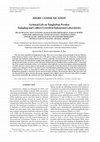
HAYATI Journal of Biosciences, 2012
The aim of the expedition to Tangkuban Perahu, West Java was to obtain archaeal samples from the ... more The aim of the expedition to Tangkuban Perahu, West Java was to obtain archaeal samples from the solfatara fields located in Domas crater. This was one of the places, where scientists from the University of Regensburg Germany had formerly isolated Indonesian archaea, especially Thermoplasma and Sulfolobus species but not fully characterized. We collected five samples from mud holes with temperatures from 57 to 88 o C and pH of 1.5-2. A portion of each sample was grown at the University of Regensburg in modified Allen's medium at 80 o C. From four out of five samples enrichment cultures were obtained, autotrophically on elemental sulphur and heterotrophically on sulfur and yeast extract; electron micrographs are presented. In the laboratories of Universitas Indonesia the isolates were cultured at 55-60 o C in order to grow tetraetherlipid synthesizing archaea, both Thermoplasmatales and Sulfolobales. Here, we succeeded to culture the same type of archaeal cells, which had been cultured in Regensburg, probably a Sulfolobus species and in Freundt's medium, Thermoplasma species. The harvested cells are documented by phase contrast microscope equipped with a digital camera. Our next steps will be to further characterize genetically the cultured cells from Tangkuban Perahu isolates.

Separation and Purification Technology, 2013
Improved isolation and effective purification of the main polar lipid (main glycophospholi pid, M... more Improved isolation and effective purification of the main polar lipid (main glycophospholi pid, MPL) from Thermoplasma acidophilum DSM 1728/10217 was achieved by a three-step procedure including (i) extraction of total lipid from lyophilized cells and removal of hydrophilic contami nants, (ii) fractionation of the total lipid via diethylaminoethyl (DEAE) cellulose chromatography and (iii) purification via a silica gel column by means of medium pressure liquid chromatography (MPLC). Adequate lipid analysis was accomplished by high performa nce liquid chromatography and high performance thin layer chromatography. The glycolipid fraction was clearly separated from the phospholipid by DEAE cellulose column chromatography, which can also be achieved by silicagel thin layer chromatog raphy in two dimensions with different solvents. The advantage of the DEAE cellulose column is a one-step de-contamination from lipophilic pigments. The final purification of the MPL by MPLC on silicage l by isocratic elution with chloroform/methanol/water 80:25:3 (v/v/v) or petrolether/2-propanol/wat er 80:70:8 (v/v/v) proved an effective method to obtain pure MPL in relatively large quantity from great amounts of cell mass within a short time. Isocratic elution allows detection of the MPL peak via refraction index. Separation of MPL can be achieved within one hour by elution with chloroform/methanol/wat er and within 100 min by elution with petrolether/2-propanol/water. Up to 150 mg of purified MPL are obtained in a single run on a column with a diameter of 2.5 cm. Our study shows that MPLC provides an effective method for the isolation of pure MPL from archaeal lipid mixtures.
... in Jakarta, Indonesia S. Handayani/C. Adhiyanto/IR Fani/J. Hidayat/DR Laksmitawati/ V. Kurnia... more ... in Jakarta, Indonesia S. Handayani/C. Adhiyanto/IR Fani/J. Hidayat/DR Laksmitawati/ V. Kurniati/RR Soegianto, d DHS Dillon,'R. Pudiantari,'BC ... tend to precipitate near the red blood cell (RBC) membrane, causing either intramedullary cell death or increased clear-ance of the ...

Medical Journal of Indonesia, 2017
Background: Archaeal membranes have phytanyl ether lipids instead of common fatty acid-glycerol e... more Background: Archaeal membranes have phytanyl ether lipids instead of common fatty acid-glycerol esters in bacterial and eukaryotic cells. Sulfolobus and Thermoplasma species have unique membrane-spanning tetraether lipids (TEL), which form stable liposomes. Recently, we cultured Thermoplasma species from the Indonesian volcano Tangkuban Perahu and isolated TEL. The purpose of this in vitro study is to investigate the transfer of fluorescent dye from stable TEL liposomes to cultured colon carcinoma cells.Methods: TEL was extracted from cultured cells with chloroform-methanol (1:1), then it was fractionated and purified via diethylaminoethyl-cellulose-acetate columns and activated charcoal for the formation of stable liposomes. For the fluorescence exchange assay, TEL liposomes were loaded with water-soluble carboxyfluorescein (CF). Staining experiments were conducted with various cell cultures, and T84 colon carcinoma cells were chosen for the main experiments. Liposome stability was...
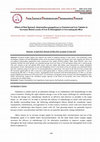
Increased oxygen supply may improve the results of radiation therapy in skin cancer. This prelimi... more Increased oxygen supply may improve the results of radiation therapy in skin cancer. This preliminary study investigates whether iron and hemoglobin levels can be increased in healthy non-anemic mice and compares the effects of red spinach (Amaranthus gangeticus) with commercial iron sulfate (FeSO 4) tablets. Male strain BALB/c mice were randomly divided into three groups, two treatment groups (oral iron doses of 50 micrograms daily) and a control group. The iron contents in the red spinach (RS) extract and iron sulfate (IS) tablets were measured by atomic absorption spectrometry (AAS). Measurement of iron and hemoglobin levels in the blood of the test animals was performed before and after treatment using AAS and UV-Vis spectrophotometry, respectively. Iron levels in the blood of mice treated with RS increased significantly by 50% vs the own control group (after vs. before; p=0.02) and by more than 60% vs. the IS-treated group (RS after vs. IS after; p=0.02). Hemoglobin levels incr...

BioFactors (Oxford, England), 2003
A study on thalassemia intermedia and major patients in Jakarta was initiated to obtain a compreh... more A study on thalassemia intermedia and major patients in Jakarta was initiated to obtain a comprehensive picture of metabolic dysregulation, iron overload, oxidative stress, and cell damage. Data are presented from a group of 14 transfusion-dependent patients in an age range of 11-25 years (T) and another group of 9 frequently transfused (for at least 15 years) patients aged 17-30 years (L). A third group comprised 6 patients (aged 7 to 14 years) who had not yet obtained transfusions (N). The 21 controls (C) were voluntary students without diagnosis or clinical signs of thalassemia up to 30 years of age. The study was approved by the Ethical Clearance Board of the Medical Faculty and all blood samples from controls and patients were obtained on fully informed consent. Levels of antioxidants (vitamins A, C, E and beta-carotene) and reactive thiols are considerably decreased in transfused patients, whereas signs of iron overload and cell damage are increased (serum iron, ferritin, tran...
Microbiology Indonesia, 2014
Medical Journal of Indonesia, 2011
... thalassemia patients in Jakarta Seruni KU Freisleben,1,2 Jenny Hidayat,1 Hans-Joachim Freisle... more ... thalassemia patients in Jakarta Seruni KU Freisleben,1,2 Jenny Hidayat,1 Hans-Joachim Freisleben,1 Soehardjo Poertadji,2 Budi Kurniawan,2 Na Peng. Bo,2 Sri Handayani,1,3 Pustika A. Wahidiyat,4 Rondang R. Soegianto5 1 ...
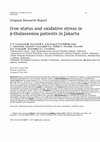
BioFactors, 2003
A study on thalassemia intermedia and major patients in Jakarta was initiated to obtain a compreh... more A study on thalassemia intermedia and major patients in Jakarta was initiated to obtain a comprehensive picture of metabolic dysregulation, iron overload, oxidative stress, and cell damage. Data are presented from a group of 14 transfusiondependent patients in an age range of 11-25 years (T) and another group of 9 frequently transfused (for at least 15 years) patients aged 17-30 years (L). A third group comprised 6 patients (aged 7 to 14 years) who had not yet obtained transfusions (N). The 21 controls (C) were voluntary students without diagnosis or clinical signs of thalassemia up to 30 years of age. The study was approved by the Ethical Clearance Board of the Medical Faculty and all blood samples from controls and patients were obtained on fully informed consent. Levels of antioxidants (vitamins A, C, E and β-carotene) and reactive thiols are considerably decreased in transfused patients, whereas signs of iron overload and cell damage are increased (serum iron, ferritin, transferrin saturation, SGOT, SGPT, γ-GT, bilirubin). Results can be summarized that non-transfused thalassemia intermedia patients exert slight signs of oxidative stress, and increased hemoglobin degradation but no significant indication of tissue or cell damage. This picture differs considerably from transfusion-dependent thalassemia major patients: highly significant decrease in antioxidants and thiols and tremendous iron overload and cell damage. The picture is even worsened in long-term transfused patients. Iron chelation after transfusion is not sufficient in Indonesia, because it is normally (with few exceptions) applied only once together with transfusion. Hence, one major reason of the bad condition of transfusion-dependent thalassemia patients in Indonesia appears to be frequent transfusions (on the average one per month) and insufficient chelation of one treatment per month together with transfusion.
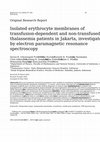
BioFactors, 2003
Erythrocyte membrane structural parameters were studied in transfusion-dependent β-thalassemia pa... more Erythrocyte membrane structural parameters were studied in transfusion-dependent β-thalassemia patients, in longterm transfused patients (regularly transfused > 15 years), and in those who had not yet obtained transfusions. Controls were voluntary students up to 30 years of age without diagnosis or clinical signs of thalassemia. Membranes were isolated and investigated by sodium dodecylsulfate polyacrylamide gel electrophoresis (SDS-PAGE) and electron paramagnetic resonance (EPR) spectroscopy. Data obtained from the thiol-reactive spin label N-ethyl-maleimidoproxyl reveal immobilization of protein environment in erythrocyte membranes from thalassemic patients. SDS-PAGE shows both degradation and aggregation of membrane proteins. Thalassemic erythrocyte membranes exert higher order parameters in the hydrophobic region as determined by 16-doxyl-stearic acid. Rotational correlation times of this spin label increase only in transfused patients. Polarity is higher in membranes of all patients than in controls. In the polar interface, order parameters obtained from 5-doxyl-stearic acid increase in non-transfused and decrease in transfusion-dependent patients as compared with controls. Transfused patients exert increasing membrane order in the hydrophobic region and counter-currently decreasing order in the polar interface indicating loss of membrane integrity along with the loss of fluidity and polarity gradients and the loss the energetic barrier function of the membrane.
The Southeast Asian journal of tropical medicine and public health, 2014
We investigated whether in addition to the well known genetic alteration in red blood cell membra... more We investigated whether in addition to the well known genetic alteration in red blood cell membrane band 3 protein, a deletion of 9 amino acids leading to ovalocytosis, other mutations to band 3 also exist. In 12% of our thalassemia major patients investigated, we found two bands in the agarose gel-electrophoresis of PCR products from band 3 gene with a difference of 65 +/- 10 bp, equivalent to a deletion of 20 to 25 amino acids in band 3 protein. Thus, a co-existing band 3-mutant allele in addition to the thalassemic globin gene defects, could also contribute to erythrocyte membrane defects and to the spectrum of clinical symptoms of these thalassemia major patients.






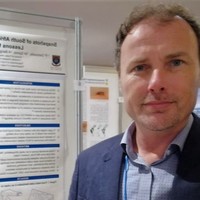



Uploads
Papers by Seruni Freisleben